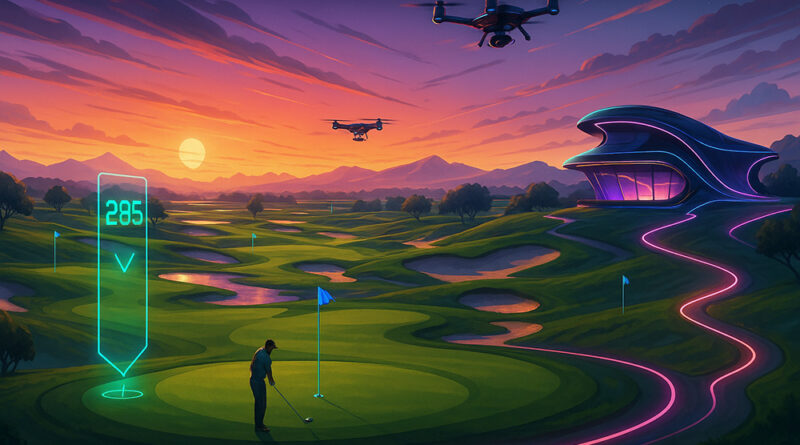The Golf Tech Paradox: Why Artificial Intelligence Will Perfect Your Slice but Never Replace the 19th Hole
It took only a few years for artificial intelligence to leap from fringe fascination to the beating heart of modern life. Algorithms nudge our shopping baskets and recommend streamed dramas, while conversational bots handle everything from legal discovery to customer complaints. No surprise, then, that golf—an ancient game obsessed with precision—is now under AI’s microscope.
From silicon valley to fairway
For hardware giants, AI has become the new graphite. When Callaway unveiled a driver face refined by an $8 billion supercomputer, the industry’s design cycle shrank from months to minutes. Rival brands followed, unleashing neural networks that iterate through thousands of face geometries before human engineers finish their first coffee. The result? Faster balls, tighter dispersion and a club market forced to chase machine-calculated marginal gains.
Coaches in your pocket
The practice range has transformed just as dramatically. Smartphone apps now film your swing, stitch it into 3-D motion data and spit out corrections within seconds. These digital gurus cross-reference untold databases of professional moves to highlight flaws your local pro might miss. Some players find this liberating; others worry that demand for traditional one-to-one lessons may dwindle. Teaching professionals are unlikely to vanish, but they will need to reposition themselves as mentors who interpret AI diagnostics rather than custodians of secret wisdom.
Wearable loopers and smart simulators
Out on the course, AI-driven watches suggest precise yardages and club choices, effectively turning your wrist into a real-time caddie. Indoors, simulators once limited to basic launch metrics now offer swing analytics sophisticated enough to feel like full clinics. They track every nuance—angle of attack, face angle, spin rate—while adjusting digital wind and terrain. It’s a far cry from early net-and-mat setups and has made high-quality practice a year-round option, even in the thick of winter.
Can AI design the next Augusta?
The prospect of a machine-generated course is both thrilling and unnerving. Imagine feeding satellite data and agronomic parameters into a model that spits out routing, contouring and hazard placement tailored to any available acreage. Golf’s romanticists shudder at the notion of an architect’s vision being replaced by statistical optimisation. They argue that the soul of a course is in subtle choices that marry artistry with land. Yet ignoring the creative potential of generative algorithms feels shortsighted; perhaps the future lies in collaborations where machines draft terrain concepts and humans add narrative flair.
Broadcast booths without broadcasters
This year’s Masters app experimented with AI commentary capable of recognising ball flights and injecting analysis in real time. The robotic cadence was jarring, but the underlying technology hinted at a future where every televised shot can be annotated instantly. Broadcasters may soon need to differentiate themselves with personality and storytelling rather than raw information delivery, because the facts will already be on-screen.
The elements AI cannot script
Despite the hype, there remain experiences beyond the reach of code. No neural network can replicate the briny tang of a seaside links breeze or the banter shared over a post-round pint. A computer may optimise strategy, but it will never feel the emotional tremor of a six-foot putt to win a friendly wager. Golf’s enduring charm lies in human frailty—and the exhilarating moments when we briefly transcend it.
Navigating the next era
Regulation lags behind innovation. Leading technologists worry that unchecked AI could drift into darker corners—weaponised systems, mass disinformation. In golf, the stakes seem quaint by comparison, yet parallels exist. What happens when equipment becomes so advanced that skill gaps shrink and classic layouts lose relevance? Governing bodies must balance progress with heritage, ensuring that technology elevates competition rather than erasing it.
Five touchpoints where AI already shapes your game
-
Club design: Supercomputers iterate face geometries at lightning speed, pushing ball speed and forgiveness to new heights.
-
Swing analysis apps: Instant, data-rich feedback is now available to anyone with a smartphone, democratising elite coaching insights.
-
Virtual caddies: Wearable devices track shots, learn tendencies and suggest clubs in real time, reducing decision fatigue.
-
Simulators: AI-enhanced indoor bays provide granular swing metrics and adaptive course conditions, making practice hyper-realistic.
-
Live commentary: Large language models interpret shots on broadcast feeds, delivering play-by-play without human lag.
Embrace, adapt, but remember the essence
Artificial intelligence is poised to keep shaving strokes and shortening learning curves. Golfers should welcome tools that make practice smarter and equipment better. Yet the game’s magic resides in its blend of nature, camaraderie and personal challenge. AI can refine technique, but it cannot replicate the smell of freshly cut fescue or the nervous laughter on the first tee.
The wisest path lies between resistance and blind embrace: leverage AI’s precision while safeguarding the quirks, stories and human triumphs that define the sport. After all, when the sun dips behind the clubhouse and the scorecards are tallied, it’s still the shared journey—however imperfect—that keeps us coming back.
Photo Credit: DepositPhotos.com

